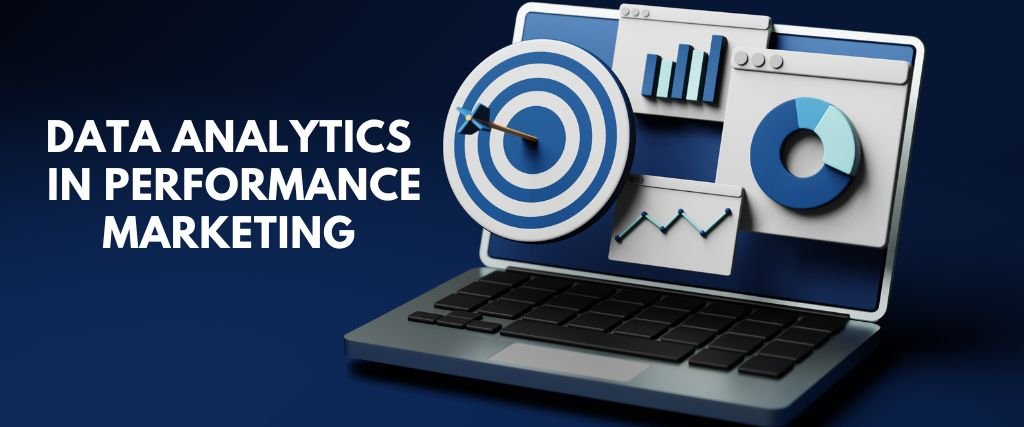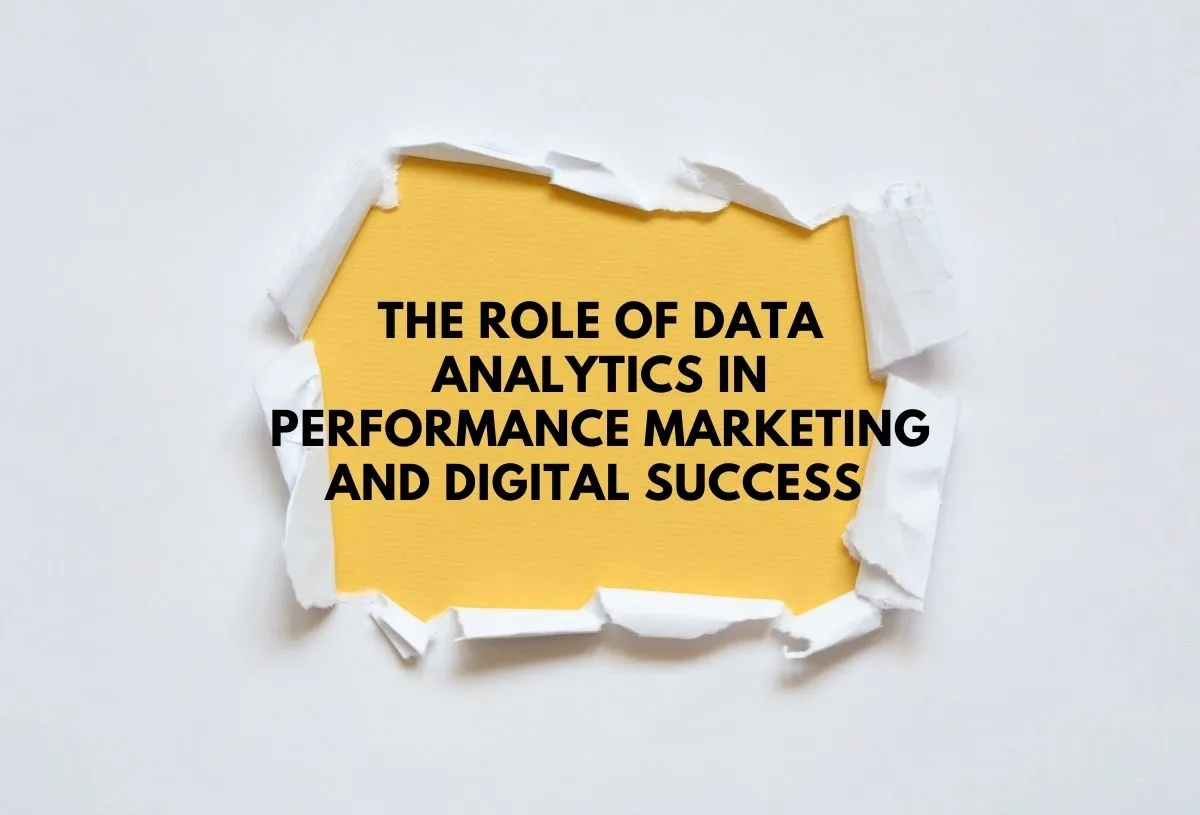
The Role of Data Analytics in Performance Marketing and Digital Success

Data analytics has become the core of effective performance marketing in the fast-expanding digital marketing landscape nowadays. In the marketing campaigns’ effort to optimize them and become productive, the utilization of data insights is not only the best way, but it is a must to do so.
Unlike traditional marketing, where outcomes are harder to measure, performance marketing ensures that marketing efforts are tied to measurable results.
From real-time data to predicting analytics, businesses can make use of the data, which can help them to improve the effectiveness of their marketing strategies and campaigns.
Moreover, it is not only understanding their audience that digital marketers use data for, but also the creation of personalized marketing experiences to maintain customer loyalty and increase return on investment.
By employing advanced analytics tools and data analysis methods, performance marketers can unlock the power of data to maximize the impact of every marketing dollar.
“With years of experience in the ever-evolving field of digital marketing, KCS (Kredence Creative Solutions) has built a reputation as a trusted authority in delivering data-driven strategies that drive real results.”
In this article, we’ll explore how businesses can make use of the benefits of performance marketing, supported by analytics in performance marketing, and create data-driven strategies that deliver better results.
The Role of Data in Performance Marketing

A very important part of performance marketing is the capability to track, measure, and optimize marketing campaigns using thorough data analysis. Businesses take advantage of the power of data to make wise business decisions, ensuring that each part of their marketing effort contributes to actual success.
Data analytics adds insights into the behavior of customers, which is one of the main things marketers use for improving their communication and offers the maximum effectiveness of their marketing campaign.
One of the huge plus points of having digital marketing analytics is the fact that user data gives a clear picture of the performance of your marketing efforts and what needs to be improved on a real-time basis.
For example, social media analytics and search engine marketing tools allow marketers to evaluate the impact of marketing in real time. This data-driven approach ensures that marketing budgets are spent wisely and key performance indicators are consistently met.
Types of Data in Digital Marketing

To achieve successful performance marketing, businesses need to study and utilize different types of data available. Each type of data plays a unique role in enhancing marketing efforts and ensuring that campaigns are effective, measurable, and aligned with business objectives.
1. First-Party Data: The Foundation of Marketing
First-party data is data collected directly from the audience, such as website interactions, purchase history, and customer preferences. Using this data, an e-commerce store can establish personalized marketing strategies and build customer loyalty.
For example, a customer can receive personalized product recommendations from an e-commerce store through their purchase history, and thus result in customer retention and an increase in sales.
2. Third-Party Data: Expanding the Reach
Third-party data is data from a data provider, which is a broader set that represents user behavior. Though this kind of data is not personal, it is important in detecting the trends and in marketing personalization of the targeted ads to the customers.
Malaysian businesses can take advantage of this data gathering to better their digital advertising and also be motivated to be the first company to enter new markets with it.
3. Historical Data: Learning from the Past
Marketers can use historical data analysis to understand and predict future performance. That means that the former type of data plays significant roles in predictive analytics, which is mainly used for the companies that are most likely to do well in the future.
For example, historical data might reveal the most effective performance marketing campaigns, providing a case study for a better success.
4. Real-Time Data: Adapting on the Fly
The ability to monitor real-time data is something that significantly alters the way businesses strategize and execute their marketing activities, thereby increasing its performance.
This real-time data technology gives performance marketers the ability to make necessary adjustments to their respective campaigns on the spot by making use of live results.
For example, if the campaign is taking place on social networks, the collected data can respond to the click-through rates and likes of posts. It can help the marketing team to push content that is already performing well enough, and at the same time to make adjustments in other low-efficiency areas so that the campaign achieves good results.
5. Social Media Data: Driving Engagement
Social media platforms generate a wealth of data that digital marketers can leverage. By utilizing the social media analytics data, businesses can decide what the targeted audience prefers, measure the engagement and therefore improve the marketing messages’ efficiency effectively.
Data Analytics Tools and Strategies in Performance Marketing

Effective performance marketing involves the use of powerful data analysis tools and proven strategies to guarantee the success of products or services. These tools do not just provide data analytics but also assist marketers to identify opportunities for improvement in terms of their marketing strategies for the best ROI.
1. Essential Data Analytics Tools for Performance Marketing
- Google Analytics: An essential tool for tracking website traffic, user behavior, and conversion rates. It provides critical information like which marketing channels are most successful in helping to accomplish specific campaign purposes.
- HubSpot Marketing Hub: It pairs marketing automation with comprehensive analytics so that marketers can evaluate their work and better campaign performance.
- SEMrush: Performs best in digital advertising analytics, keyword performance, and competitive benchmarking.
- Sprout Social: A platform primarily focused on social media analytics that offers insight into audience engagement and relates content with data.
- Adobe Analytics: It provides comprehensive data analysis and predictive analytics for large scale marketing efforts.
2. Data-Driven Strategies for Successful Campaigns
- Set Clear KPIs: Key performance indicators are what can indeed develop the success of the campaign if one is to identify and track them. As a result, the marketing team both aligns its efforts with the business goals and gets specific data for growth.
- Personalized Marketing: The utilization of customer data to send out personalized marketing messages and offers is the way to go. If a good e-commerce company can recommend products that are suggested by browsing history, it can lead to a great customer experience, enhancing conversions and driving.
- Leverage Predictive Analytics: By leveraging predictive analytics models to anticipate customer behavior, businesses can adopt a more transparent and data-driven approach to marketing. This allows them to allocate budgets strategically, targeting resources where they’ll have the greatest impact—maximizing marketing success while optimizing spending.
- Optimize in Real Time: Digital marketers using the digital data can make the necessary changes to their marketing immediately. The result of this was obviously better outcomes and no progressive operational imperfections.
3. The Role of Analytics in Performance Marketing
- Enhancing Customer Experience: Data analytics helps marketers understand audience preferences, enabling them to create campaigns that resonate.
- Identifying High-Value Channels: Analytics pinpoints the top performance marketing channels, helping businesses focus their efforts for maximum impact.
- Ensuring Data Privacy: With regulations like the General Data Protection Regulation (GDPR), businesses must balance data collection with ethical practices to build trust and foster customer loyalty.
With these tools and strategies in place, companies can take advantage of the power that data offers to improve their performance marketing campaigns.
In the next section, we will concentrate more on the advantages of performance marketing and some of how businesses can improve their overall marketing performance.
Benefits of Performance Marketing

More than just being able to track and measure results, performance marketing can turn companies into marketing magicians who know how to effectively market and not waste money.
Such a marketing model in Malaysia is appealing because it is capable of boosting the company to drive up customer numbers, offset negative performance, and improve campaign profitability.
1. Cost-Effective and Measurable Results
Unlike traditional marketing—which is often difficult to measure—performance marketing creates a direct link between budget allocation and results, ensuring cost-effective campaigns with clear ROI.
This clear track record allows businesses to fine-tune their marketing plans by concentrating on methods and channels that drive the most revenue.
Example: A Malaysian online retailer decided to use search engine marketing as the main channel to target the potential customers who actively search for them. They finally ended up with a 35% growth in sales even remaining within their original budget just by analyzing the conversion rates and adjusting campaign settings in real-time.
2. Improved Customer Targeting
With the use of data analytics tools to analyze customer data, businesses can now find the exact audience segments that exist in their database for more targeted ads. These customer-specific approaches drive customers to see a company as credible and, consequently, buy the products.
3. Enhanced Flexibility and Scalability
Real-time data enables companies to adjust campaigns in real-time, optimizing strategies to boost profits while reducing inefficient spending. Additionally, these campaigns are naturally scalable, allowing businesses of all sizes to adapt and grow their efforts seamlessly.
4. Data-Driven Decision-Making
Data analytics is the most important tool for companies which helps in the best decision making of their products’ marketing. By making forecasts based on the predictive models and the past performance of data, digital marketers get to improve their approaches and gain better results.
5. Improved Customer Experience
Through utilizing data, companies can provide a great customer experience by delivering marketing messages and offers that are customized to the specific needs of the customer. This customization not only enhances consumer satisfaction but also makes them come back repeatedly.
Insight: The Power of Data in Building Trust
With the current attention focused on data protection issues, companies have to be strict to keep their marketing data GDPR-compliant. The correct and truthful use of data is an ingredient for developing and preserving customer trust.
The importance of performance marketing is why it is an attractive option for companies that want to stand out in the modern digital marketing environment.
In the next section, we’ll explore top performance marketing channels and how businesses can use them effectively.
Top Performance Marketing Channels

One of the key challenges businesses face in achieving digital marketing success lies in identifying the most effective performance marketing channels. Success depends on selecting platforms that are not only available but also strategically aligned with the target audience—enabling continuous optimization for maximum campaign impact and ROI.
We’ll talk about the most effective performance marketing channels and how companies can make the best use of them.
1. Search Engine Marketing (SEM)
SEM refers to performance-based marketing in which through the Google search engine, paid ads are run. Through the use of data insights from such tools as keywords, clicks, and conversions, the company can adjust their campaigns to attract a greater audience and earn a higher return on investment.
To give an example, we can say that a Malaysian retailer of electronics used the SEM to set the highest-intent keywords such as “best budget laptops.” Through the data monitoring process they reduced their cost-per-click by 20% and generated twice as many conversions.
2. Social Media Advertising
Social media platforms such as Facebook, Instagram, Xiaohongshu and LinkedIn give marketers the flexibility of assessing the success of their content marketing strategies in social media.
By being able to check how the ads are performing in real-time, companies can not only modify their marketing messages and offers but also opt for better ad performance according to their audience’s response to their promotion.
Case Study: A local cafe had put up Instagram ads to get people to buy, offering them a time-limited discount. Having analyzed the social media data, they recognized this as the time of peak engagement and so they have increased their ROI two times during the campaign.
3. Affiliate Marketing

The term affiliate marketing refers to a marketing method that involves the advertisers paying marketing companies or individuals based on the sales or leads that they generate.
Those in charge can, via data analytics tools, check the performance of an affiliate to find out the best channels and partners.
Advice: A local eye-wear company cooperated with some of the top local bloggers for launching their products. They found out which influencers are the most valuable by tracking referrals and managed to grow the affiliate program.
4. Programmatic Advertising
Programmatic advertising automates the buying and placement of digital ads (e.g., banners, video ads) using real-time bidding and data-driven algorithms. This allows businesses to target specific audiences—based on demographics, behavior, or interests—with precision. Programmatic platforms analyze detailed performance data (impressions, clicks, conversions) in real-time, enabling instant optimization of ad creatives, budgets, and placements to maximize ROI while minimizing wasted spend.
Channels for Better Results

Combining multiple channels into a unified marketing strategy is essential for companies to effectively reach their target audience and maximize return on investment (ROI).
Businesses can apply a variety of performance marketing channels to collect data on potential customers, and that data can be used to help them with targeting marketing campaigns that are most appropriate to their audience, i.e. those that will bring the desired results.
In the next section, we will look at the challenges that arise when the data is utilized in digital marketing and how it can be resolved to make the company keep hand in hand with the success.
Challenges of Using Data in Digital Marketing

One cannot deny the role of data in the successful performance of marketing campaigns. However, managing it effectively comes with various difficulties.
Business organizations, no matter what country they are from, need to surpass these barriers in order to make the best use of data in digital marketing.
1. Data Privacy and Compliance
- The requirement is obviously legal compliance, and to achieve this, the company must determine how to ensure that its data sources and collection practices comply with the law
- Transparency plays an important role as companies are obliged to be transparent in the way they collect, store and use customer data to gain the trust of customers.
- Insight: A local financial services provider overhauled its data collection process to be in line with GDPR. In comparison, they elevated customer loyalty to a new level through trust built on transparency, not only did they manage to follow the standards set but they also won the confidence of their customers.
2. Data Overload
- The large amount of data in digital marketing can be bewildering to marketers, which often prevents them from targeting the ideas for improvement.
- Businesses have to put critical data types on top and do filtering, organizing, and the analysis of the most influential metrics, which will be done through analytics tools.
“A Malaysian company simplified their data tracking by focusing on key metrics like conversion rates and customer acquisition costs, resulting in a more efficient marketing plan.”
3. Integration of Data from Multiple Sources
- Marketing companies are known to collect marketing data from multiple sources such as websites, social media, email platforms, and more. Bringing these into one, understandable picture is a challenging but necessary way to form a single data-driven strategy.
4. Ensuring Data Accuracy
- The submission of inaccurate or out-of-date data can result in a low level of decision-making and throw away the marketing budget. Keeping data integrity should take into account regular auditing of data and reliance on trustworthy data providers.
“A digital advertising agency conducted quarterly data reviews to eliminate errors and outdated information, which significantly improved their campaign performance.”
5. Balancing Personalization and Privacy
- While personalized marketing delivers better results, excessive data collection may feel intrusive to customers. Businesses must strike a balance between delivering value and respecting privacy.
6. Limited Knowledge of Analytics Tools
- Many businesses, especially SMEs, lack the expertise to use advanced analytics tools effectively. Training and upskilling marketing teams are essential to overcome this challenge.
“A small business invested in workshops to train their team on using Google Analytics and predictive tools. This initiative led to a more data-driven approach and higher ROI from their digital marketing strategies.”
7. Data Silos
- Departments working in isolation often lead to data silos, preventing businesses from leveraging a unified strategy. Collaboration between teams is critical for analyzing data holistically.
Overcoming the Challenges
To address these challenges, businesses should:
- Invest in user-friendly data analytics tools that simplify data analysis.
- Develop policies for ethical data collection and ensure compliance with privacy regulations.
- Provide training for marketing teams to enhance their ability to use data insights effectively.
- Regularly audit and update marketing data to maintain accuracy.
Keep marketing data in check by regularly auditing and updating marketing data or it will lose its accuracy. Aside from that, companies will get the maximum out of the return on investment from performance marketing only if their marketing efforts will bring them tangible, measurable success.
Conclusion: Unlocking the Power of Data for Performance Marketing Success

The era of data-driven marketing has redefined how businesses approach their marketing efforts. By embracing the role of data in performance marketing, businesses in Malaysia and beyond can gain a competitive edge in the digital marketing landscape.
At Kredence Creative Solutions (KCS), we enable businesses across Malaysia with data-driven, results-focused digital marketing strategies. Our goal is simple: to prioritize measurable outcomes that align with your objectives, ensuring every campaign delivers real value and clear results. Whether you’re refining your strategy or scaling new heights, our team is here to guide your next strategic move. Let’s turn your goals into achievements—contact us today to begin.

